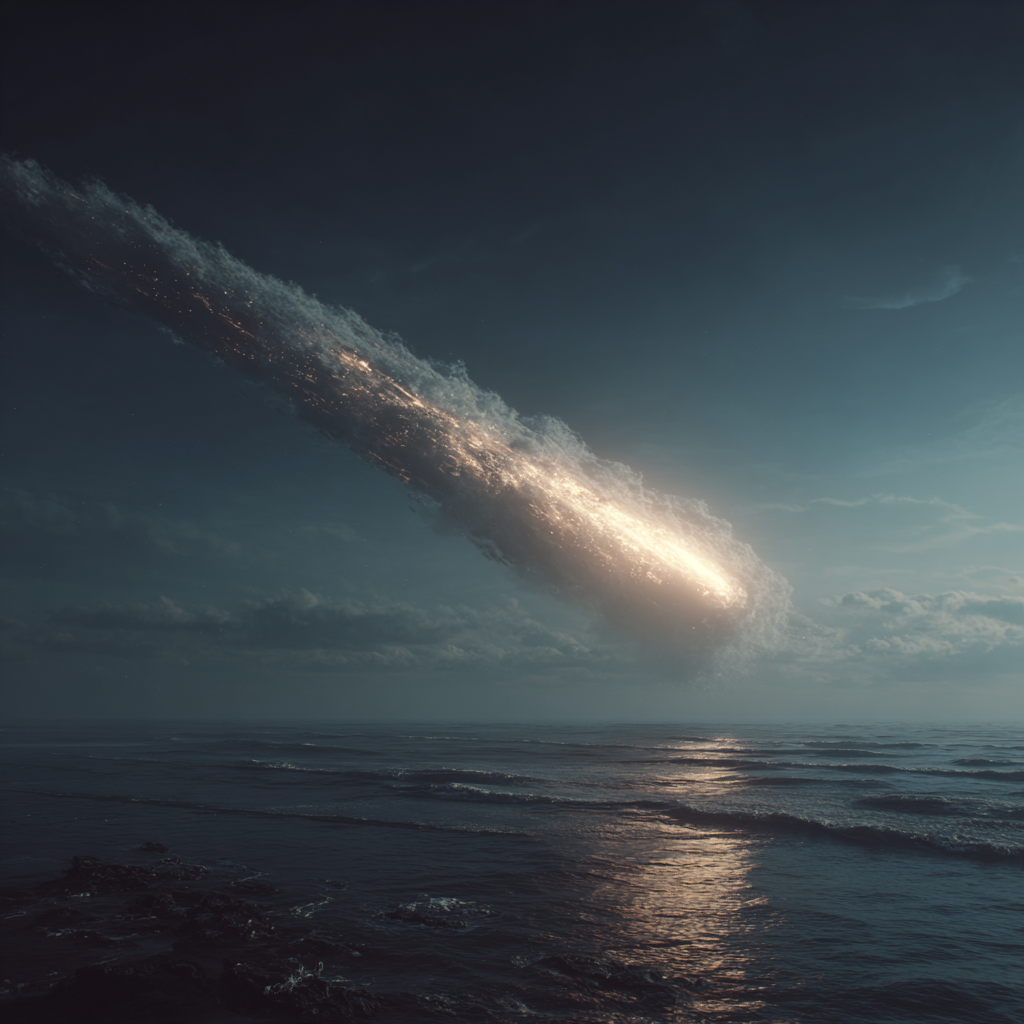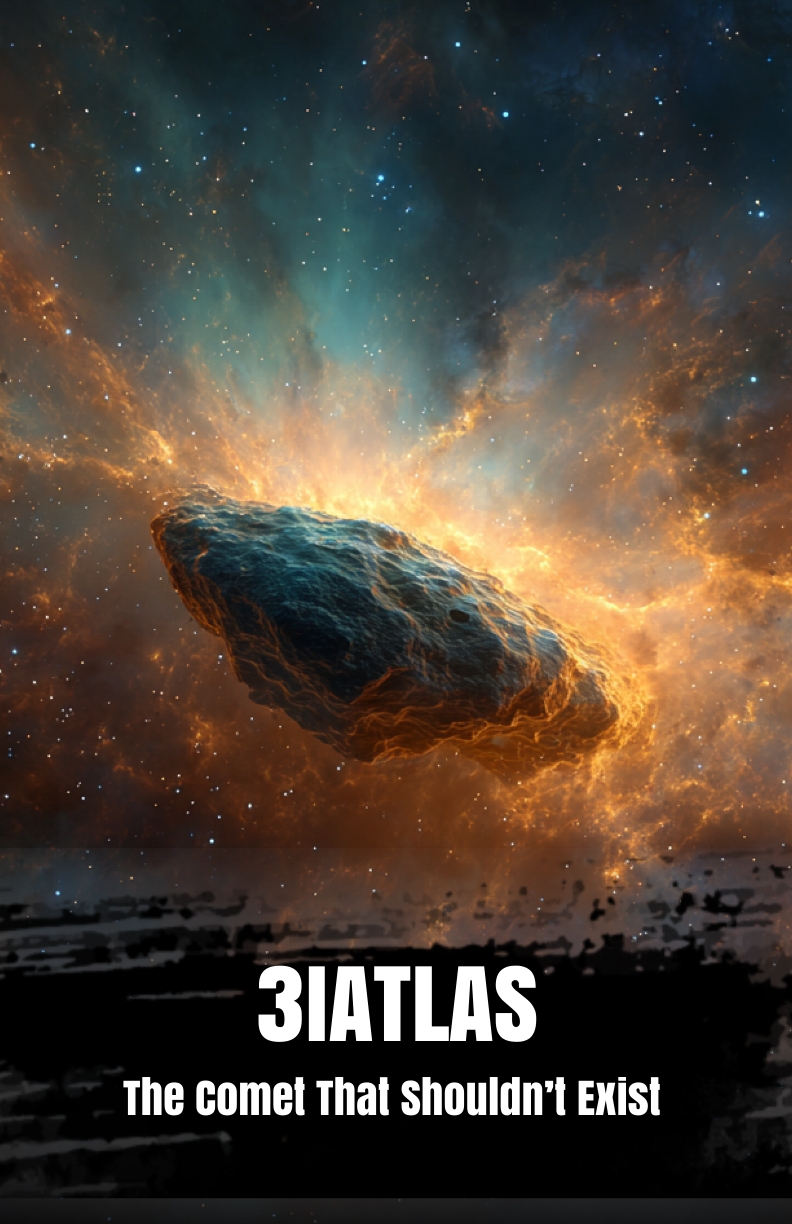Your cart is currently empty!
The Shattered Skyline

An unreleased short story from the book: 3I/ATLAS: The Comet That Shouldn’t Exist
It began on the fifty-second floor.
The tower’s cleaning crew were the first to notice—though they didn’t understand what they were seeing at the time. It was dusk, and the city’s glass giants were catching the last gold light of the day. But when the sun dipped low, the north-facing windows didn’t reflect the streets or the crisscrossing streams of headlights below. Instead, they mirrored the comet.
Not faintly, not as a vague distortion in the glass—perfectly. As if the building had been skinned with hundreds of identical, flawless lenses, all locked on the same alien object in the eastern sky.
3I/ATLAS, C/2025 N1, once called A11pl3Z before its path and nature were confirmed—an interstellar visitor. Astronomers had been tracking it for months, mapping its velocity and strange trajectory. It was moving too fast for anything bound to the Sun, sweeping in from a vector far beyond Pluto’s aphelion, and with a coma that glowed faint green under spectrographic analysis, cyanogen and diatomic carbon shimmering like something living.
To the naked eye, it looked like a pale, unblinking pupil, suspended between constellations. But now, in the glass, it seemed closer. Too close.
I was there because I worked across the street, on the forty-eighth floor of the Evermere Building. My office faced east, so when the cleaning crew began whispering about the “comet windows” in the Keldron Tower, I went to look.
The sight was impossible to mistake. Entire floors—dozens of them—reflected nothing but the comet, its pale-green halo flickering faintly as though the glass itself was alive. The city below? Gone from the image. Even the sunset sky behind me didn’t register.
It was wrong, but mesmerizing.
People stopped in the plaza to watch. Phones came out. The comet in the sky and the comet in the glass seemed subtly different—its reflection was brighter, its tail sharper, as if revealing a truer form.
That was the first night.
The next evening, it spread.
Now it wasn’t just Keldron Tower. Windows in buildings blocks away were changing. Whole swaths of the skyline wore that same alien gaze, their mirrored faces locked onto the comet, no matter their angle or orientation. It didn’t matter if the glass faced north, south, or straight down an alley—the reflection was always of the comet, its halo pulsing faintly with slow, deliberate rhythm.
And then came the sound.
It began as a faint hum, almost below hearing, a pressure more than a noise. You could feel it in your jaw, in the hinge of your skull. Standing in front of the windows for too long made your vision pulse at the edges, your heartbeat syncing to something outside yourself.
The news stations filmed it, of course. Experts speculated about light polarization, atmospheric distortion, even some previously unknown optical property triggered by the comet’s unique spectrum. But none of them could explain why it was happening only in our city.
The first cracks came three nights later.
I was leaving late, the streets half-empty under the comet’s cold glow. The last smear of sunlight had vanished behind the rooftops when I heard it—a sound like brittle porcelain under tension. I looked up.
The glass on the forty-fifth floor of the Keldron Tower had split. A single hairline fracture ran through the reflection, distorting the comet’s core into something jagged, prismatic. And from that fracture, something dark began to seep.
It wasn’t water. Even in the half-light, it was too viscous, too deliberate. The liquid crawled downward in slow beads, leaving streaks that glistened faintly as they slid. When one drop hit the sidewalk far below, it didn’t splatter—it clung to the concrete like oil, shimmering faintly before absorbing into the stone.
The crack widened with a slow groan. More black fluid emerged, and beneath the sheen of the glass, the comet’s reflection seemed to pulse harder, faster, its halo trembling like a living thing straining to break free.
By the next night, almost every building in the downtown core had cracks.
Not all leaked, but those that did left stains—long, thin trails of shadow that no cleaning crew could scrub away. I watched one worker try, his squeegee dragging through the black smear as if through molasses. The next day, he didn’t show up for work. The foreman said he hadn’t gone home at all.
People began avoiding the windows after sunset. You could still pass by them safely during the day, but once the light dimmed, something in the reflection shifted. The comet looked closer—too close—and the fractures in the glass seemed to spiderweb outward when you weren’t looking directly at them.
And the liquid…
Sometimes, it moved upward.
Two nights before the comet’s perihelion, the skyline was unrecognizable. Every reflective surface—offices, high-rises, even polished steel facades—showed nothing but the comet. The actual sky was pale with its glow, but in the glass, the green was deeper, richer, like staring into an ocean trench.
The cracks widened faster now, sometimes bursting with a soft, wet pop. The liquid that followed didn’t always obey gravity. I saw it cling to the inside of the glass, crawling sideways, branching like veins.
And there were shapes in it.
Small, slow-moving things, their outlines distorted by the fluid’s shifting density. They swam lazily, then pressed against the glass, their forms flattening until they looked like handprints. But they weren’t hands. Not exactly. The digits were too long, the angles wrong.
People were disappearing.
At first, it was just rumors—someone staying late at the office, seen staring into a window after dark, then gone by morning. No signs of forced entry, no broken glass, just a smear of black fluid near where they had stood.
Then it happened in the open.
A man walking through the plaza stopped in front of the Keldron Tower, staring at the comet’s reflection. The glass fractured suddenly, a sharp, ringing crack that echoed like a gunshot. He reached out—not quickly, not like a man in shock, but slowly, deliberately. His palm touched the black fluid, and it surged outward, swallowing his hand, then his arm, then pulling him flat against the surface.
I swear I saw the glass ripple around him before he was gone, his outline dissolving into the reflection.
And in the next pulse of green light from the comet, there was another shape swimming in the fluid.
The final night, the comet hung enormous in the real sky. Its tail stretched across half the horizon, green bleeding into the clouds. In the glass, it was so close it seemed you could reach out and touch it.
The hum was everywhere now, not just near the buildings—throbbing in the air, in the bones. The cracks had spread into intricate lattices, the black fluid coursing through them like veins. And in every pane of glass, the shapes pressed closer, crowding, overlapping, their forms writhing against the barrier.
I stood in the empty street, the wind dead, the air heavy.
The first pane shattered.
Not cracked—shattered. The glass didn’t fall. It melted, sagging into a curtain of liquid shadow.
And from it, something stepped through.
If you enjoyed this short story you will probably like our latest release available now:
3I/ATLAS: The Comet That Shouldn’t Exist
It came from the darkness between the stars… and it should not be here.
When astronomers first spotted 3I/ATLAS—officially designated C/2025 N1 (ATLAS)—they thought it was just another icy visitor from the edge of our solar system. But within days, the data told a far stranger story. This was no ordinary comet.

Leave a Reply